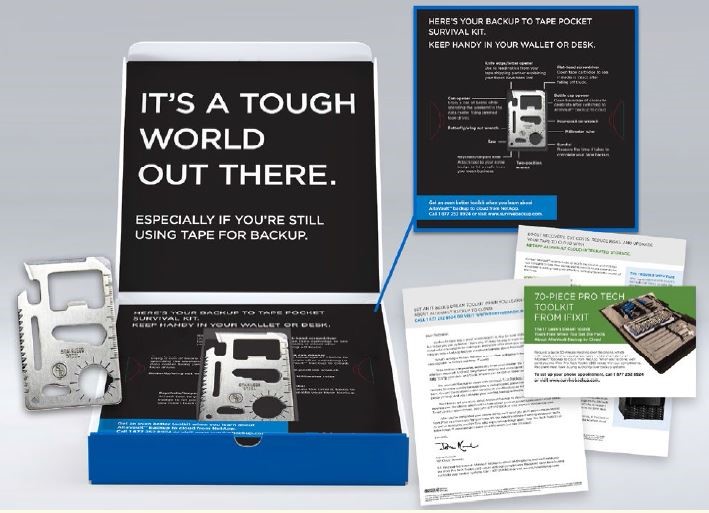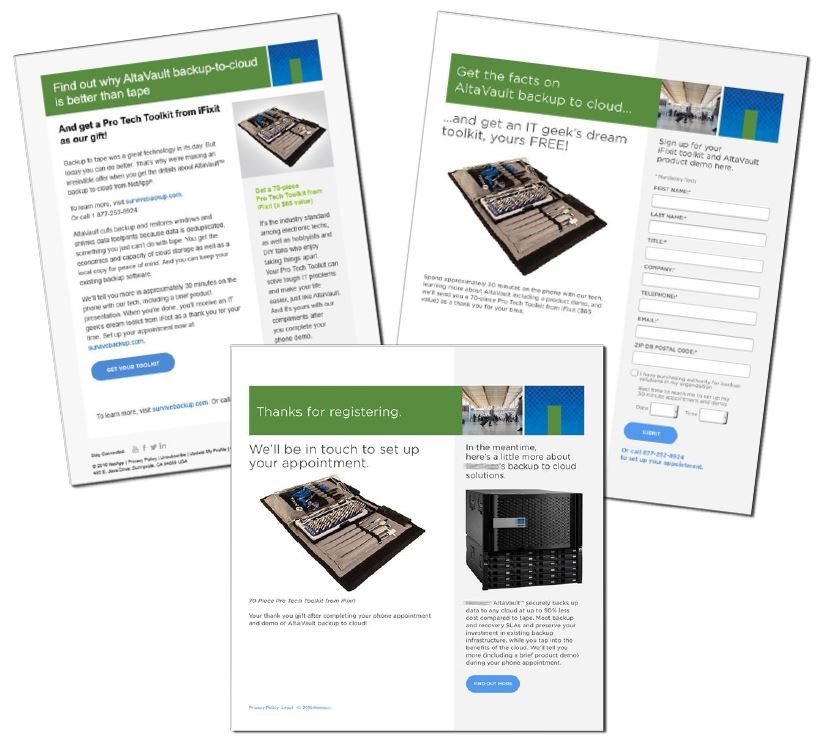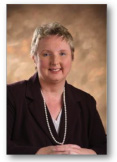Defining the Problem
IT decision makers are a wily bunch. They tend to ignore most marketing efforts. They’re usually engineers and thus highly skeptical of advertising claims. And they’re so busy that even if you do connect, it’s difficult to keep their attention for more than a microsecond.
Our campaign for a Fortune 500 network storage company was designed to leap over all these hurdles. We needed to reach the executives in charge of backup solutions. Then tell them, in a nice way, that the tape systems they used and trusted were unsafe and obsolete. Our success would be measured by our ability to set up appointments for Sales to present a live product demo.
Fortunately, Beasley had worked with our immediate client at a previous company on a successful strategy to generate sales appointments. This was through a multi-touch campaign built around a high-impact direct mail effort. Such a campaign is not inexpensive. But the rewards are great because of the prospect of a high value sale (in this case in excess of $40K) at the end of the process. We estimated that if we could generate 42 demos the campaign would pay for itself. Our client was able to sell it internally, and we were on our way.
Direct Mail Design
The first step was to design an engaging, memorable, viral direct mail package. We didn’t want to offend their loyalty to existing backup-to-tape systems and “if it ain’t broke, don’t fix it” mentality. We needed to convince prospects that backup-to-cloud might be a superior solution and they could learn about it risk-free.

Our direct mail package was built around a “pocket survival tool” mounted on a shelf with verbal call-outs to situations where engineers might need it in their daily job.
Our approach was to talk about “surviving backup to tape” and focus on all the challenges that might make life difficult for the manager using that solution. A dimensional box teased “Pocket Survival Kit Enclosed” with the subhead: “Are you still using tape for backup? Then you’ll need this.” Inside, the prospect found a credit card-size pocket tool with screwdriver, bottle opener and similar capabilities. The gadget was mounted on a shelf with callouts to the functions that tied them to the hazards of tape backup—like weekends lost in the data center fixing problems (use our can opener to enjoy a can of beans).
A letter countered with a presentation of the benefits of our client’s solution, and made the offer of an “even better toolkit” as a reward for a phone demo. Additional flyers spotlighted our client’s backup to cloud technology and the “IT Geek’s Dream Toolkit” which they could get with a demo.
Building a Contact List
While the creative was in development, our teleservices partner built the contact list. We wanted to be sure everybody who entered our contact stream was a prospective buyer. Therefore, we merged several list sources then called storage departments to verify name, contact information and buying authority. As a result, this process had an unexpected benefit: when they were exposed to our message and creative platform, six prospects set demos on the spot, putting us on the path to achieving our goal before we even went in the mail.
Strategizing Your Distribution
The direct mail went out with a staggered distribution so we could control the lead flow. We followed up with two email touches. Even with the high-impact format we didn’t anticipate a large initial response. The reason, because of the many distractions faced by our target audience of overworked engineers. We expected 10-15% of our demos to come from response to the direct mail and a follow-up email contact. Instead, 28% of demos would be generated through these channels: 48 mail responses plus 18 email responses. (If you’re keeping track, you’ll notice we were already ahead of plan.) Six of the inbound responses were from prospects not in the original database. This meant the recipient had taken the trouble to pass along the offer to someone else in their company—a rare phenomenon in tech marketing.

An email followed up our direct mail with the same offer. Once a prospect filled out the registration form, they were called to schedule a demo appointment.
Follow-Up Calls and Closing the Sales Appointment
A few days later, a series of follow-up calls began with the objective of completing a sales prospecting script through one or multiple calls. Telesales reps reported that the executives they spoke with were highly engaged. They remembered the direct mail and offer, and were eager to talk about it. They found the “Ultimate IT Geek’s Toolkit” an appealing reward for their time sales appointment to get the demo. Recipients appreciated the research we had made to match the premium (a set of jewelers-quality tools used for tinkering with electronics) to their interests. As a result, 65% of completed scripts were converted to demo appointments, vs an anticipated 10%.
At the five-month mark, two hundred and thirty demos had been scheduled vs plan of 42—a 5x improvement over our goal. Based on conservative estimates and extensive previous experience with similar campaigns, we project that the sales-to-cost ratio to be $4.62 in revenue for every dollar invested.
Lessons Learned
The lesson: even the most elusive tech target can be found and engaged in a sales demo. If you are willing to make the investment to build an appealing message with offer and gain their attention through a high-impact first effort, then spend the time to follow up.

Laurie B. Beasley
Laurie B. Beasley is co-founder and president of Beasley Direct and Online Marketing, Inc. Beasley Direct is a Silicon Valley direct marketing agency that has managed search, email, online, and demand generation campaigns for nearly 100 companies. Ms. Beasley serves as President of the Direct Marketing Association of Northern California. Laurie manages the eMarketing Roundtable for the BMA Northern California. She is also an instructor of online marketing at UC Berkeley Extension and teaches for the Online Marketing Institute. Ms. Beasley frequently speaks on online marketing and demand generation topics for marketing organizations, including the DMA, BMA, AMA, Tech Council, and the Online Marketing Summit.
Beasley Direct and Online Marketing, Inc. is known for bringing the latest marketing strategies to online and direct marketing. The company provides services in email marketing, search engine optimization, social media, pay-per-click (PPC) advertising, website design, media planning, direct mail marketing, lead generation and nurture campaigns, and database management. Beasley Direct and Online Marketing, Inc. helps clients in both B2B and B2C marketing. Beasley Direct and Online Marketing is privately held and headquartered in the Silicon Valley suburb, Morgan Hill, California. For more information, go to www.BeasleyDirect.com or call Laurie Beasley, President, at 408-782-0046 x21 or email lbeasley@beasleydirect.com.

